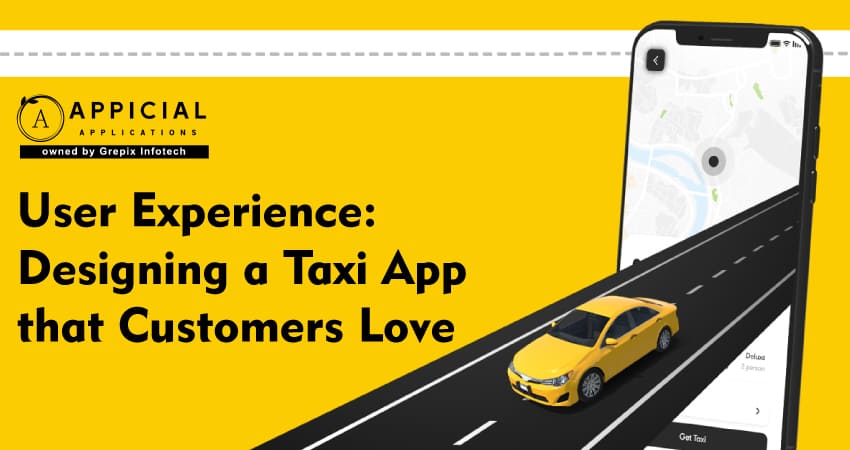
User Experience: Designing a Taxi App that Customers Love
Designing a taxi app that customers love requires a deep understanding of their needs, coupled with a commitment to delivering intuitive, reliable, and delightful experiences. By focusing on user-centric features, prioritizing accessibility, and leveraging advanced technologies, you can create an app that not only meets expectations but exceeds them. Remember, a great taxi app is more than just a tool for booking rides, it’s a trusted companion for seamless urban travel.
In today's fast-paced world, convenience is king. With the rise of on-demand services, taxi apps have become an integral part of urban transportation. They offer a seamless way for users to get from point A to point B with just a few taps on their smartphones. However, in a market saturated with options, how does one design a taxi app that not only stands out but is also loved by its users? The answer lies in exceptional user experience (UX).
Designing a taxi app that customers love demands a deep understanding of user needs and a commitment to delivering intuitive, reliable, and accessible experiences. Successful apps focus on features like seamless onboarding, real-time tracking, transparent pricing, and multiple payment options while prioritizing simplicity, usability, and safety. Personalization, instant feedback, and continuous performance optimization further enhance the user experience. Appicial Applications excels in creating user-centric taxi apps by leveraging advanced technologies and innovative design principles. By addressing evolving user expectations and building trust, Appicial Applications ensures their apps become indispensable tools for modern urban mobility, driving convenience and loyalty.
Understanding User Needs
Before diving into design and features, it's crucial to understand who your users are and what they need. Users of taxi app are diverse ranging from daily commuters and business travelers to tourists exploring a new city. Conducting thorough user research helps in identifying common pain points such as complicated booking processes, lack of driver information, and unreliable estimated arrival times. By empathizing with users, designers can create solutions that address these issues directly.
Key Features That Enhance User Experience
A successful taxi app must include the following core features:
1 Simple Onboarding Process
The onboarding experience sets the tone for your app. Avoid overwhelming new users with too much information or complex registration steps. Use:
- Social Login Options: Allow users to sign in using their Google, Apple, or Facebook accounts.
- Progressive Onboarding: Introduce app features gradually to reduce cognitive load.
- Clear Instructions: Guide users with tooltips and visual cues during their first interaction.
2Seamless Booking Flow
The booking process should be intuitive and quick. Users value apps that allow them to book a ride in a few taps. To achieve this:
- Pre-filled Details: Use GPS to auto-detect the user's location as the pickup point.
- Favorite Locations: Allow users to save frequently visited places like “Home” or “Work.”
- Predictive Suggestions: Show location suggestions based on ride history.
3 Real-Time Tracking
Real-time ride tracking builds trust and reduces anxiety. Integrate:
- Interactive Maps: Use a high-quality map interface with clear visuals.
- ETA Updates: Continuously update users on the estimated time of arrival (ETA) of their ride.
- Driver Profile and Vehicle Details: Display the driver’s name, photo, and license plate to enhance safety.
4 Transparent Pricing
Unclear or fluctuating fares can frustrate users. To maintain transparency:
- Fare Estimates: Provide upfront fare estimates based on distance, traffic, and demand.
- Dynamic Pricing Alerts: Inform users when surge pricing is active and why it’s applied.
- Breakdown of Charges: After the ride, show a detailed breakdown of the fare.
5In-App Payment Options
Cashless payments are a must for modern taxi apps. Include:
- Multiple Payment Methods: Support credit cards, digital wallets, and local payment systems.
- Split Payment Feature: Allow users to share the fare with co-passengers.
- One-Tap Checkout: Save payment details securely for faster future transactions.
6 Feedback and Support
A feedback mechanism not only helps improve the app but also makes users feel heard. Integrate:
- Ride Ratings: Enable users to rate drivers and their experience.
- Open-Ended Feedback: Allow comments for specific suggestions or complaints.
- 24/7 Support: Provide live chat or a helpline for immediate assistance.
Design Principles for a Delightful UX
1Prioritize Simplicity
Taxi apps are used on the go, often in hurried situations. A clutter-free interface ensures that users can navigate effortlessly. Adhere to:
- Minimalist Design: Keep screens clean, with ample white space and only essential elements.
- Consistent Icons: Use universally recognized icons for booking, canceling, or contacting the driver.
- Clear Typography: Choose legible fonts and appropriate sizes for text.
2 Enhance Accessibility
Design your app to be inclusive and accessible to all users. This includes:
- Voice Commands: Integrate voice search for users with limited mobility.
- Color Contrast: Make sure there is enough contrast so that users who are blind or visually impaired can read it.
- Language Options: Offer multilingual support for diverse audiences.
3 Provide Visual Feedback
Instant feedback reassures users that their actions are registered. For example:
- Animations: Show a loading animation when searching for nearby taxis.
- Confirmation Prompts: Display a “Ride Confirmed” message after booking.
- Error Indicators: Highlight fields with issues, such as invalid payment details, in real-time.
4 Optimize for Speed
Slow-loading apps can drive users away. Ensure:
- Quick Map Loading: Use lightweight APIs for fast map rendering.
- Efficient Backend: Minimize server-side delays for actions like ride confirmation or fare calculation.
- Offline Mode: Allow users to view past bookings or saved locations without an active internet connection.
Also Read: How Ride-Sharing Apps Reduce Carbon Footprints: A Case Study
Designing for Simplicity and Usability
The application's user interface should be clear and simple. Overloading the app with too many features can overwhelm users. Employing a minimalist design with clear icons and instructions enhances usability. Accessibility is another critical aspect designers should ensure that the app is usable by people with disabilities, adhering to guidelines like the Web Content Accessibility Guidelines (WCAG). Localization features, such as language support and cultural considerations, make the app more accessible to a global audience.
Enhancing User Experience
Beyond basic functionalities, additional features can significantly enhance user experience. Personalization allows the app to remember user preferences, such as favorite locations or preferred payment methods, speeding up the booking process. In-app chat support provides immediate assistance, resolving issues without the need to exit the app. Timely notifications keep users informed about their booking status, driver arrival, and any changes due to traffic conditions. Safety features, such as an emergency button or the ability to share trip details with trusted contacts, are increasingly important to users concerned about personal security.
Performance and Reliability
An app's performance directly impacts user satisfaction. Fast loading times and smooth transitions between screens keep users engaged. Regular updates and maintenance are necessary to fix bugs and improve functionality. While constant internet connectivity is required for most features, incorporating offline capabilities, such as viewing trip history or accessing saved locations, can enhance usability in areas with poor network coverage.
Feedback Mechanisms
Incorporating feedback mechanisms allows users to express their opinions and report issues. Rating systems for drivers and the overall experience help maintain service quality. Providing easy ways to report problems, such as incorrect charges or app glitches, shows users that their concerns are valued and addressed promptly. This continuous loop of feedback and improvement keeps the app aligned with user needs.
Building Trust and Loyalty
Trust is a cornerstone of user retention. Ensuring data privacy by following stringent security protocols protects user information and builds confidence. Consistent branding across the app, website, and customer communications reinforces the company's identity and reliability. Implementing rewards and loyalty programs encourages repeat use by offering incentives like discounted rides or referral bonuses.
Conclusion
In today’s competitive landscape, designing a taxi app that customers love requires more than just robust functionality, it demands a thoughtful, user-first approach that anticipates and addresses user needs at every turn. From seamless onboarding to intuitive booking flows, real-time tracking, and accessible design, every element of the app must work in harmony to deliver a delightful experience. By focusing on simplicity, transparency, and personalization, taxi apps can establish themselves as indispensable tools for modern urban mobility.
Appicial Applications a leading taxi app development company understands the importance of crafting experiences that resonate with users. Our commitment to innovation, accessibility, and continuous improvement ensures that the taxi apps we develop not only meet expectations but consistently exceed them. By leveraging advanced technologies, such as AI-driven recommendations and robust safety features, and prioritizing user-centric design principles, we help create apps that inspire trust and loyalty.
Ultimately, a taxi app is more than just a platform for booking rides, it’s a bridge that connects people to places, facilitates convenience, and simplifies daily life. With a relentless focus on user satisfaction and adaptability to evolving trends, Appicial Applications helps businesses deliver taxi apps that are not only functional but also beloved by their customers. Together, let’s drive the future of urban transportation forward.
Looking out to start your own venture like Uber? Try out our HireMe Taxi Uber Clone, the easiest way to kick-start your taxi business.Author's Bio

Vinay Jain is the Founder at Grepix Infotech and brings over 12 years of entrepreneurial experience. His focus revolves around software & business development and customer satisfaction.
Back to blog list






